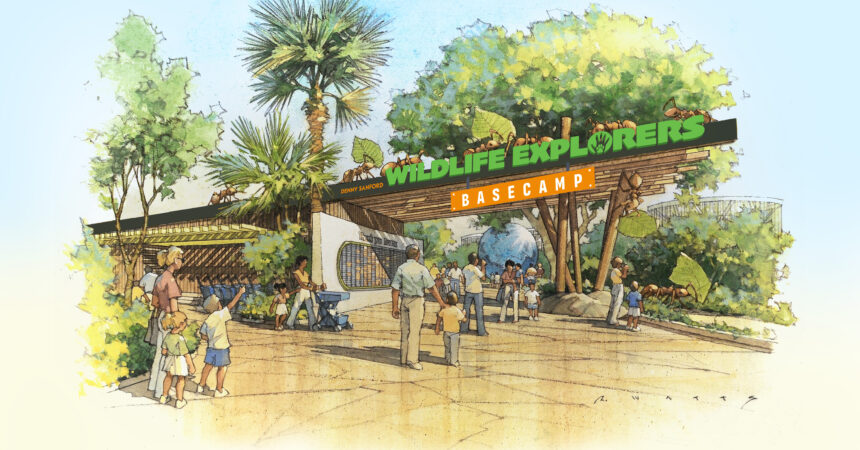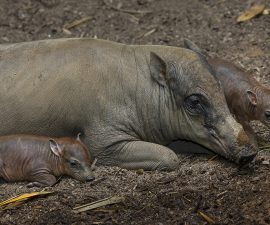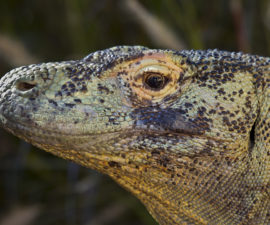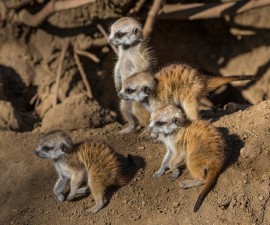Expansive New 3.2-acre Environment Opening in February 2022 Is Designed to Educate, Entertain and Inspire Empathy in the Next Generation of Conservationists
SAN DIEGO (Oct. 29, 2021) – San Diego Zoo Wildlife Alliance (SDZWA) is expanding its mission to help all life thrive by cultivating some of its most important allies—the next generation. Opening in February 2022, the 3.2-acre Denny Sanford Wildlife Explorers Basecamp at the San Diego Zoo will be a place where guests and their families can enjoy an exciting experience that inspires empathy for all wildlife.
“The new and innovative elements of Wildlife Explorers Basecamp encourage our explorers to gain a better understanding of their role in the natural world by getting a glimpse of life from the wildlife’s point of view,” said Paul A. Baribault, president and chief executive officer of San Diego Zoo Wildlife Alliance. “It’s a fun, accessible and meaningful way to discover how we’re all connected, and that the health of the smallest members of the wildlife community is inextricably linked to our own human health.”
San Diego Zoo Wildlife Alliance is grateful for the 3,092 donors who contributed more than $87 million to Wildlife Explorers Basecamp, with foundational gifts given by Denny Sanford, Ernest and Evelyn Rady, the McKinney family, The Conrad Prebys Foundation, the Una Davis family, the Bob and Marion Wilson family, Art and Danielle Engel, the Hervey Family Fund at The San Diego Foundation, and the Zuest family.
“The name reflects the underlying goal of the area,” said Shawn Dixon, chief operating officer of San Diego Zoo Wildlife Alliance. “We are calling it a Basecamp because it’s designed to serve as a launch pad for budding conservationists of all ages to be inspired to care for and protect the future of our planet.”
Built on the site of the former Children’s Zoo, Wildlife Explorers Basecamp is designed to appeal to a broader audience, while maintaining its place in the hearts of young explorers. The area blends innovation and immersive technology with opportunities to check out extraordinary species—ranging from leafcutter ants and orb weaver spiders to prairie dogs and sloths—all designed to introduce the next generation to the natural world with an eye toward the future.
Wildlife Explorers Basecamp is divided into four types of habitats and features the wildlife that live in these areas— Rainforest, Wild Woods, Marsh Meadows and Desert Dunes. Included throughout the space will be breathtaking and remarkable wildlife experiences to bring audiences up close to nature as never before, interactive play opportunities, oversized species-themed sculptures and a one-of-a-kind floating, seven-foot-high stone globe representing the Earth and how we are all connected.
The common element underscoring the play and learning opportunities at Basecamp is nurturing the future caretakers of the planet. The experience uses special sensory elements to create a multifaceted engagement approach, with microscopes and touch screens, plus animation and dynamic lighting installations.
The Rainforest area of Basecamp is centered around the 10,000-square-foot McKinney Family Spineless Marvels building. It features arachnids, crustaceans and insects, including free-flying butterflies and moths, a two-story leafcutter ant experience, a coconut crab habitat and a world of spiders, scorpions, stick insects, katydids, beetles, mantises and more. The pollinator experience pairs a real-life beehive with a larger-than-life honeycomb, inviting young guests to become the bee. Within this immersive space, they will also learn about the fascinating lives of our own native bees and other pollinators like African flower beetles and butterflies.
A cool rainforest canopy immerses guests in the environment, as they are surprised by a host of Rady Wildlife Ambassador animals, such as a two-toed sloth or a prehensile-tailed porcupine. The two-story Rady Ambassadors Headquarters building will host habitats for most of the Zoo’s wildlife ambassadors.
Wild Woods is an area for wildlife species including coatis and squirrel monkeys. While crossing The Conrad Prebys Foundation Discovery Bridge, guests immediately encounter an “ancient oak tree” that is more than 20 feet tall. It is built for kids to climb, and provides a parallel-play experience because it is adjacent to the squirrel monkey habitat. This dynamic nature-play tree structure offers multiple points of access for guests—from a suspension bridge and net tunnel to a spiral staircase in the middle. Water-play extends into this woodland-themed area, with a waterfall grotto and splash pad, water jets and a stream—plus, a bluff area with a boulder scramble at the side for exploration.
Marsh Meadows is designed with an array of plant life, strategically designed to attract native bird species, butterflies and bees. There is also the two-story Art and Danielle Engel Cool Critters building that offers 7,000 square feet of immersive environments, digital media and learning opportunities. The wildlife here includes snakes, amphibians, crocodilians, turtles and lizards, including endangered Fijian iguanas. It also showcases the of the kind of partnerships SDZWA forges with the U.S. Geological Survey (USGS), Nature Fiji and the National Trust of Fiji, to preserve delicate ecosystems and build successful breeding colonies of Fijian iguanas. Just outside, a watery habitat is designed to immerse guests—seemingly literally—as they make their way to underwater viewing areas featuring reptiles and fish.
The Desert Dunes section of Wildlife Explorers Basecampfeatures animals including fennec foxes, prairie dogs and burrowing owls, a key species for the Alliance. A dry desert wash themed area takes center stage in this part of Wildlife Explorers Basecamp, with boulder play opportunities for climbing, scrambling, hopping and more. Hidden reptile sculptures and petroglyphs can be found among the rocks and cool caves that offer shaded areas for guests to beat the heat, like their desert species counterparts.
“We want to play a role in building future conservationists by creating lasting memories that inspire empathy and curiosity; encourage innovation, collaboration, resilience and optimism; and shine a light on the interconnectedness of the health of wildlife, people and the environment they share,” said Nadine Lamberski, DVM, chief conservation and wildlife health officer at San Diego Zoo Wildlife Alliance.
To achieve this, San Diego Zoo Wildlife Alliance ensured the habitat design was rooted in research.
“We consulted with child development experts early in the design process, who said if you want future generations to really have empathy for wildlife, they need to see the world from the animals’ perspective,” added Chief Operating Officer Shawn Dixon. “Wildlife Explorers Basecamp is an engaging, hands-on adventure, seeding hope and optimism, where wildlife and guests can be active and engaged.
###
About San Diego Zoo Wildlife Alliance
San Diego Zoo Wildlife Alliance is a nonprofit international conservation leader, committed to inspiring a passion for nature and creating a world where all life thrives. The Alliance empowers people from around the globe to support their mission to conserve wildlife through innovation and partnerships. San Diego Zoo Wildlife Alliance supports cutting-edge conservation and brings the stories of their work back to the San Diego Zoo and San Diego Zoo Safari Park—giving millions of guests, in person and virtually, the opportunity to experience conservation in action. The work of San Diego Zoo Wildlife Alliance extends from San Diego to strategic and regional conservation “hubs” across the globe, where their strengths—via their “Conservation Toolbox,” including the renowned Wildlife Biodiversity Bank—are able to effectively align with hundreds of regional partners to improve outcomes for wildlife in more coordinated efforts. By leveraging these tools in wildlife care and conservation science, and through collaboration with hundreds of partners, San Diego Zoo Wildlife Alliance has reintroduced more than 44 endangered species to native habitats. Each year, San Diego Zoo Wildlife Alliance’s work reaches over 1 billion people in 150 countries via news media, social media, their websites, educational resources and the San Diego Zoo Kids channel, which is in children’s hospitals in 13 countries. Success is made possible by the support of members, donors and guests to the San Diego Zoo and San Diego Zoo Safari Park, who are Wildlife Allies committed to ensuring all life thrives.





